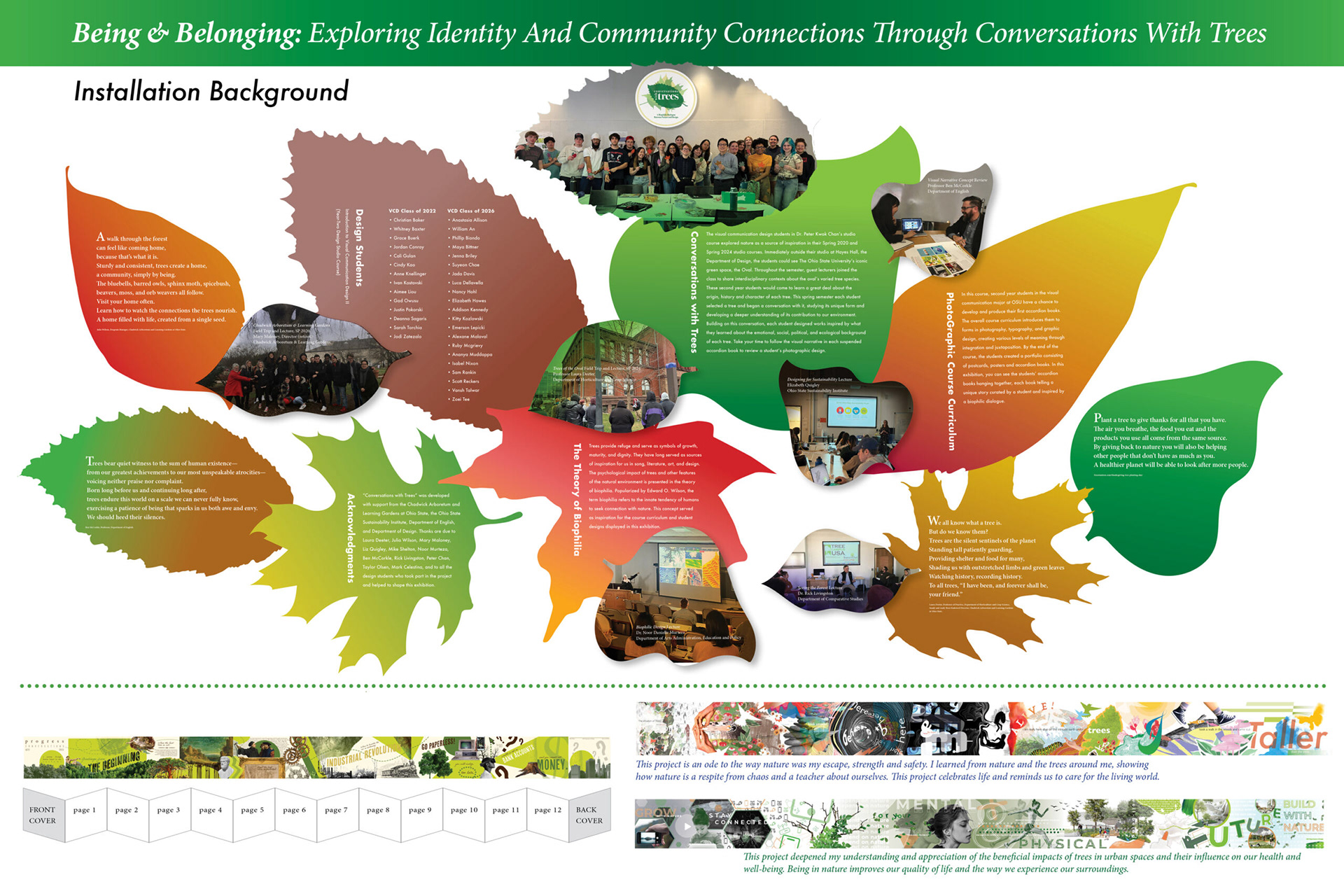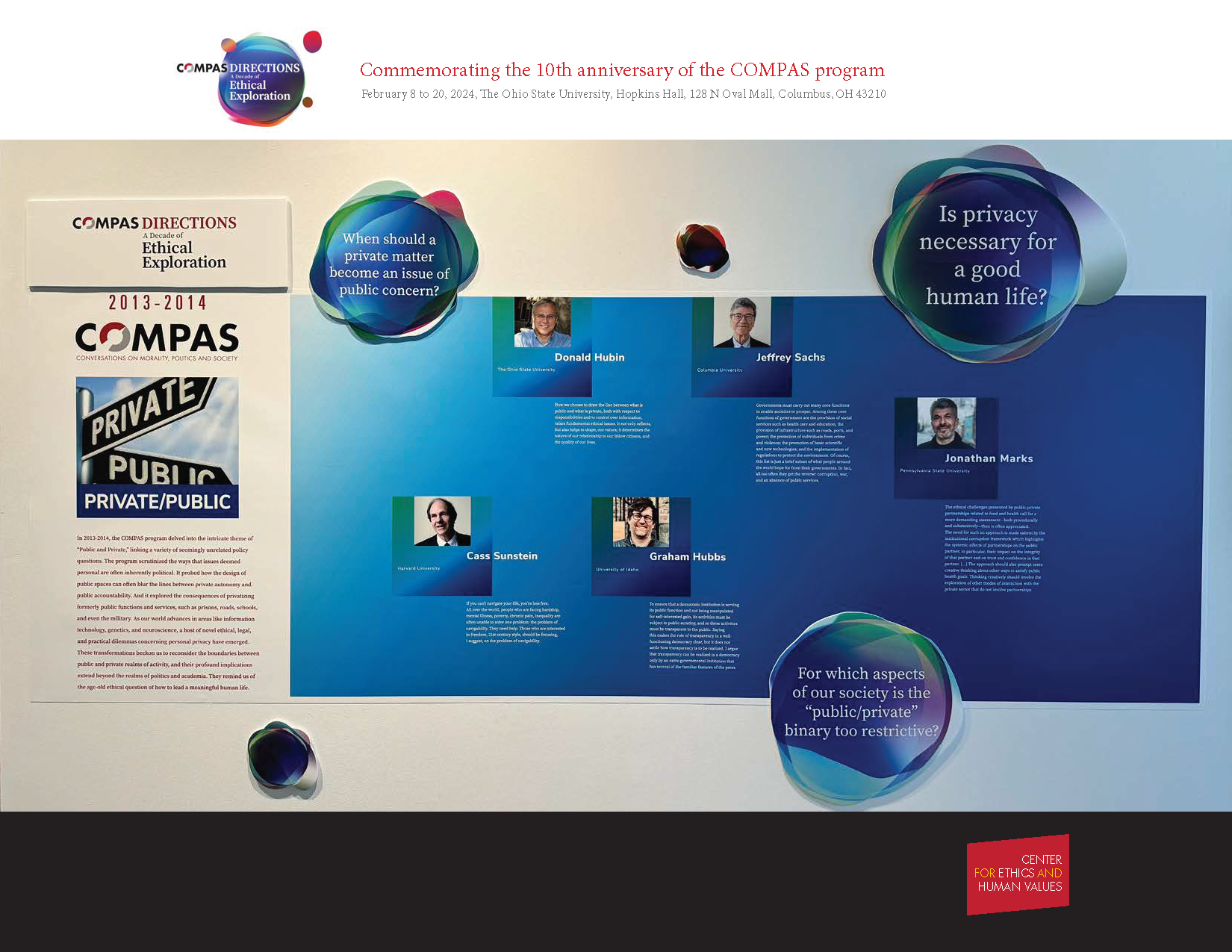Conversations with Trees: A Biophilic Dialogue Between Nature and Design
Role: Exhibition Designer/Crafter, Fabrication (laser-cutting) Assistance, Installation
Collaborators: Peter Chan, Noor Murteza, Mark Celestina, Ben McCorkle
Description:
Visual Communication Design students in Dr. Peter Kwok Chan’s studio course embarked on a journey into nature as a wellspring of creativity during their Spring 2020 and Spring 2024 sessions (Conversations with Trees). Nestled beside Hayes Hall, within sight of The Ohio State University’s renowned green expanse, the Oval, these students found inspiration at their doorstep. Throughout this spring semester, guest lecturers enriched their understanding of the Oval’s diverse arboreal inhabitants, unveiling the origins, histories, and unique characteristics of each tree. Engaging in an intimate dialogue with nature, these second-year students selected individual trees to study, examining their distinctive forms and deepening their appreciation for their environmental significance. Drawing from these conversations, each student crafted visual narratives encapsulating the emotional, social, political, and ecological dimensions of their chosen tree, presented in captivating 14-page accordion book compositions. (Collaborators: Peter Chan, Noor Murteza, Mark Celestina, Ben McCorkle)
Displayed: Chadwick Arboretum/Knottman Hall, Mingei International Museum (San Diego), Urban Arts Space, Kuhn Fine Arts Gallery




CEHV: 10th Anniversary of the COMPAS program
Role: Motion Graphics & Audio, Logo Design/Animation (COMPAS Directions), Exhibition Designer/Crafter, Installation
Collaborators: Peter Chan, Noor Murteza, Mark Celestina, Piers Turners
Description:
The exhibition, titled COMPAS Directions: A Decade of Ethical Exploration, underscores the ongoing importance of these dialogues and lauds the myriad insightful pathways participants have forged in addressing their collective ethical dilemmas throughout the past decade. By convening esteemed guests and colleagues from various fields and viewpoints, COMPAS fosters a dynamic arena for nuanced comprehension and transformative problem-solving. It fosters meaningful exchanges among experts and attendees alike, providing a stage for critical and constructive communal introspection.
Reflecting on this collaboration, Professor Piers Turners, CEHV Director, expresses his gratitude towards “the entire design team - Peter, Taylor, Noor, and Mark - for breathing life into our COMPAS program with such vibrancy and engagement. The exhibit beckons all to delve into a decade’s worth of discussions on challenging subjects, while also honoring the interdisciplinary bonds we have cultivated at Ohio State University. Peter’s visionary leadership, coupled with the invaluable contributions of each team member, has culminated in a remarkable and captivating experience. It has been a rewarding journey, and the outcome is both compelling and refined.”
Displayed: Hopkins Hall Art Gallery





Toward a Digital Humanities Support Network
Role: UI/UX Designer || More info: ACCAD Digital Humanities Support Network
The Ohio State University’s faculty and graduate students have been applying digital humanities (DH) approaches to research for decades. This expansion of DH practice has reached a point that necessitates establishing cohesive, sustainable cross-disciplinary support and resources. Since conducting an environmental scan in 2016-17, Digital Humanities Librarian Leigh Bonds has advocated for the adoption of a “network model”—“a linked network of units, groups, and practitioners who contribute expertise to the overall pool” (Educause Center for Analysis and Research, “Building Capacity for Digital Humanities: A Framework for Institutional Planning,” 2017). This project undertakes the construct of this network and the implementation of a web publishing platform for digital collections, drawing upon established expertise in a variety of units—ACCAD, Libraries, and Humanities Institute, to support both funded and unfunded faculty and graduate student research through collaboration, consultation, instruction, and referrals within the network.
(CMS systems used: Scalar & Drupal. Sites demonstrated below)
Flowchart of the Digital Humanities process throughout development. Software: Miro
Example: Chinese Theater Collaborative
The Chinese Theater Collaborative website offers tools for learning about the rich history of traditional Chinese drama and its contemporary interpretations. One of the resources provided by the website is an extensive list of Chinese plays for the user to select from. Each play is described and analyzed in detail in the educational modules linked.
Animated backgrounds as users are introduced to the site: Chinese Theater Collaborative


Example: COVID food archive
The Covid Food Archive is a digital archive that invites users to share how they ate during the pandemic by contributing media to the website. The "Browse All Items" page of the Covid Food Archive allows users to sift through the recipes, stories, and images posted to the archive. More info: Discovering how COVID-19 impacted U.S. eating habits (Site discontinued -- project shifting to new management for future food endeavors)


Debunking contraceptive myths
Role: Animation, Motion Graphics, Compositing || More info: Debunking Contraceptive Myths
In a grant to help debunk contraceptive myths in Kingston Jamaica, ACCAD teamed with project PI Dr. Maria Gallo, Associate Professor in the College of Public Health’s Division of Epidemiology to help educate adult women about contraceptive options in Kingston, Jamaica. This study is also a first-time collaboration between Gallo and ACCAD. Gallo and the research team hope to debunk myths and confusion surrounding contraceptive safety. Contraceptive methods often go unused because of false concerns about the side effects and health risks associated with them, according to Gallo. To address the study, ACCAD designed and produced a four-minute motion-graphics video debunking myths about contraception based on a script devised by Gallo and the medical research team. “Our primary aim is to determine whether long-acting reversible contraceptive initiation is higher among women who watch the debunking video, compared to those in the control group after three months of follow-up,” Gallo said. Palazzi and Design MFA students Taylor Olsen and Breanne Butters developed storyboards and characters for the script and then participated in stakeholder sessions with women in Kingston to evaluate and refine the script and visuals to address their needs and suggestions. The resulting video will be now be used in a study of 220 adult, reproductive-age women in Kingston to determine its effectiveness.


